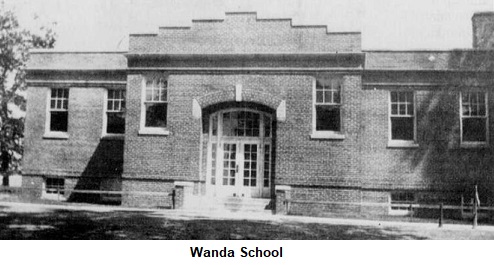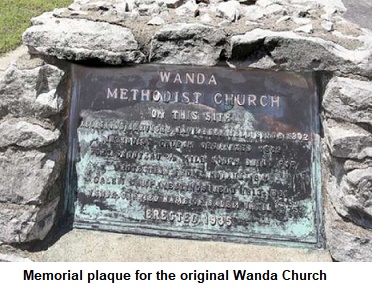Early History of Wanda (Old Salem or Gillham)
The Founding of Old Salem, or Gillham
Old Salem, the original name of Wanda, is located on Wanda Road, in
the northeast corner of Section 1 of Chouteau Township, near South
Roxana. It received its name from the old Salem Church just north
across the line in Wood River Township. In later years, the area
around Wanda was known as Oak Grove.
John Gillham Sr. was born January 4, 1756. He served as a Lieutenant
in the Revolutionary War. In 1802 he brought his wife, Sarah Clark Gillham,
and children to Illinois from South Carolina, and settled in the
American Bottoms in the Old
Salem (Wanda) area. It is possible that he received land grants due
to his military service. Their children were: Margaret Gillham Brown
(1776-1851; married Samuel Parker Brown); Ann Gillham Dunnagan
(1778-1838; married Thomas Isaiah Dunnagan); James Harvey Gillham
(1781-1867; married Mary Polly Good); Ryderus Clark Gillham
(1783-1846; married Susannah G. Brown, then Ruhamah Patterson in
1824); Sarah Gillham Brown (1787-?; married Daniel S. Brown);
Charles Gillham (1789-1849; married Sealy Medford in 1822, then Mary
Murphy in 1828); Mary Gillham Cox (1795-1848, married Thomas Cox);
Elizabeth Gillham Cox (1795-1852, married Micajah Cox); Rev. John
Gillham Jr. (1798-1835, married Phebe Dunnagan); and Rev. William
Gillham (1802-1854, married Mary McKinney in 1823). Of these
children, Ann, James, Ryderus, Rev. John, and Rev. William Gillham
are known to be buried in the Wanda Cemetery. Lt. John Gillham,
father of the above children, died at Old Salem on December 13,
1834, at the age of 78. His wife, Sarah, died in March 1832. They
are both buried in the Wanda Cemetery. Salem was subsequently named
Gillham after this Gillham family.
Thomas “Isaiah” Dunnagan came to Illinois in 1803, and settled in
Old Salem in Wanda. He married Ann Gillham, daughter of Lt. John
Gillham Sr. Isaiah Dunnagan erected a log cabin and improved a small
farm. He later built a larger log home. Isaiah and Ann had six
children: Joshua, Thomas, Louisa, Abner F., Joseph C., and Isaiah
Jr. Dunnegan.
John Springer settled in Old Salem in 1810. He was a devote
Christian, and held the confidence and esteem of all who knew him.
Two of his sons became ministers.
The Founding of Wanda (Station)
In 1859, a post office was established near the residence of E. K.
Fahnestock, in a small building used as a broom factory. Abner
Fahnestock served as the first postmaster. The post office was
called Wanda Station, a name given by the Wabash, St. Louis, and
Peoria Railroad. The name change was necessary as there were three
Salems in Illinois at the time. The
railroad supplied transportation for goods and people from the
nearby farmlands. In 1874, Jacob K. Fahnestock built and opened a
general store, to which the post office was moved. He operated the
store and was postmaster until his death on November 01, 1899. His
nephew, LeRoy Fahnestock, took over the business and served as the
next postmaster.
Early Wanda Schools
The church at Old Salem, built by Ryderus Clark Gillham, served as the
first schoolhouse. The frame building was built of hewn timbers
tenoned and put together with draw-pins. The siding was made of
split-boards rived in the timber and nailed on with homemade,
hand-forged nails. It had a dirt floor. The seats were made of black
walnut, to the backs of which were hinged a board which could be
propped up like a shelf for school use, and lowered for church
purposes. Drawers were made to slide under the seats to hold school
materials and Bibles, from which the children learned to read and
spell. In September 1921, a new school in Wanda was dedicated. The
two-room schoolhouse was erected at a cost of $15,000, and was
designed with folding doors between the two rooms, so that the doors
could be thrown open to make a large auditorium for plays and other
gatherings. The basement included a playroom for the children during
times of inclement weather.
Early Wanda Church
The Methodist society at Salem was formed at the home of Thomas
“Isaiah” Dunnagan in 1809, with 17 members: Thomas Isaiah Dunnagan,
Ann Dunnagan, James Gillham, Polly Gillham, Ryderus C. Gillham,
Susanna Gillham, George Davidson, Jane Davidson, Polly Davidson,
George Sanders, Hannah Sanders, John Kirkpatrick, Sally Kirkpatrick,
Thomas Kirkpatrick, Polly Kirkpatrick, Anna Dodd, and Sally Salms.
This Methodist society was one of the first in Madison County.
A frame church was constructed in 1812, near the residence of Isaiah
Dunnagan, on the extreme southeast corner of Township 5, Range 9.
The building was constructed of hewn timbers tenoned and put
together with draw-pins. The siding was made of split-boards, rived
in the timber and nailed on with homemade, hand-forged nails. It had
a dirt floor. The seats were made of black walnut, with a hinged
board on the back which could be propped up like a shelf for school
use. Drawers were made to slide under the seats. In 1828, a new
frame church was erected across the street from the Fannestock
General Store. John Gwilliam deeded two and a half acres of land on
which to build the church. This building was destroyed by fire, but
was replaced by another structure.
In 1838, the church members laid out campgrounds adjacent to the
church. Tents were placed in rows for traveling ministers to preach
to the settlers, who came in covered wagons from as far away as 50
miles. Yearly camp meetings were held there until 1861.
In 1952, Wanda resident, Charles Noble Simpson. Left enough money to
the church in the will to build a brick structure.

